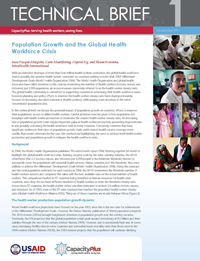November 2011
Sara Pacqué-Margolis, Carie Muntifering, Crystal Ng, and Shaun Noronha, IntraHealth International

With an estimated shortage of more than four million health workers worldwide, the global health workforce crisis is possibly the greatest health system constraint on countries seeking to meet their 2015 Millennium Development Goals (World Health Organization 2006). The World Health Organization and global health advocates have called attention to this crisis by monitoring the number of health workers (doctors, nurses, and midwives) per 1,000 population, an access measure commonly referred to as the health worker density ratio. The global health community is committed to supporting countries in addressing their health workforce crises; however, planning and policy efforts to improve the health worker density ratio have disproportionately focused on increasing the ratio’s numerator (health workers), while paying scant attention to the ratio’s denominator (population size).
In this technical brief, we discuss the potential impact of population growth on countries’ efforts to improve their populations’ access to skilled health workers. Careful attention must be given to how population size interplays with health worker production to determine the desired health worker density ratio. An increasing rate of population growth could negate important gains in health worker production, preventing improvements in and possibly worsening the health workforce crisis in many countries. Conversely, countries that have significant declines in their rates of population growth could reach desired health service coverage more quickly than would otherwise be the case. We conclude by highlighting the need to address both health worker production and population growth to mitigate the health workforce crisis.
Next >>
A printer-friendly version is available in English and French.